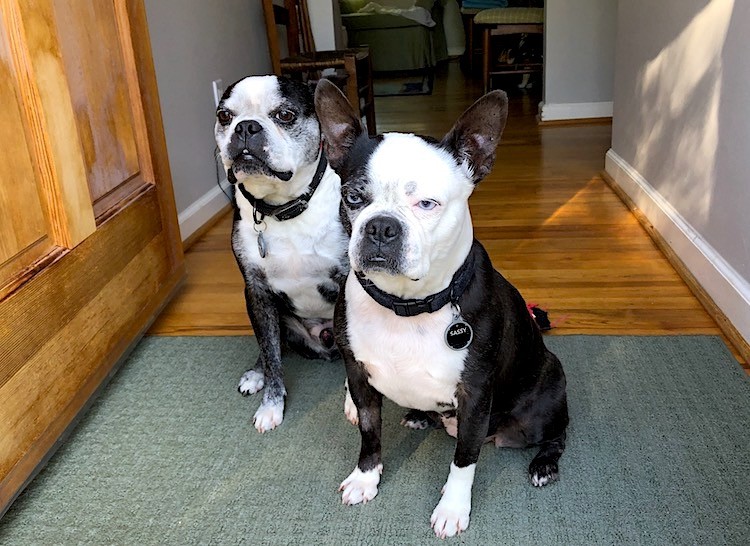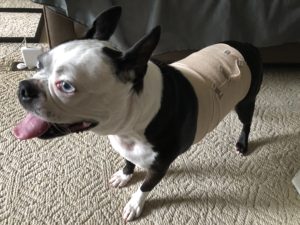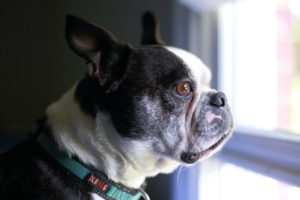As we navigate this COVID-19 pandemic, are your pets at risk of developing separation anxiety? Are you worried you might see separation anxiety in your dogs when the pandemic is over?
Some dogs are already having a hard time.
The good news is – you can help your dog avoid or lessen the development of separation anxiety. Start now!
I am not a veterinarian nor an animal behaviorist. I present my understanding of health or behavior issues based on personal experience and research I’ve done. If you have a dog with health or behavioral issues, seek professional guidance. I hope you find my post useful.
More dogs will develop separation anxiety issues during this public health crisis
Indeed, dog trainers are already sounding the alarm: they expect an uptick in the number of new separation anxiety cases once the coronavirus pandemic passes and we can all return to our new normal, whatever that is going to be!
Foster dogs are not exempt and are especially affected by this pandemic if they develop separation anxiety. It is harder to find an adopter for a dog with separation anxiety.
When we return to “normal”, we will leave our pets and foster dogs at home, assuming they know things just went back to normal. They will remember the old routine. They’ll flex and adjust, and all will be well.
Not always.
If we do not make changes now to our routines and training, it’s possible our dogs will struggle with the abrupt changes in routines. We can make the transition easier by making changes now.
A Brief Overview of Separation Anxiety
Truth: Separation anxiety is the same thing as a panic disorder!
Symptoms of Separation Anxiety
Dogs with separation anxiety may exhibit behaviors such as
- panting
- drooling
- vocalizations (whining, grunting, barking)
- pacing
- emptying their bladder and/or bowels indoors (even when they are perfectly housetrained)
- destructive behaviors
- tearing up their bedding in the crate
- chewing up your personal belongings
- chewing up furniture
- chewing window sills. door jambs, and even chewing through drywall!
Dogs With Separation Anxiety Are NOT Being Angry and Spiteful
Some might say this behavior is nothing more than your dog acting out towards you for leaving them at home, accusing the dog of being angry or spiteful. Some punish the dog for this “bad” behavior.
This is NOT true!
Your dog isn’t being angry, bad, spiteful, or passive-aggressive. Please don’t punish this behavior. Separation anxiety is a true panic disorder, and your dog is having a surge of anxiety and panic when they are behaving this way. They are unable to calm themselves down on their own.
Is separation anxiety in dogs a new problem?
Decades ago, you’d rarely hear about separation anxiety in dogs. We lived differently and our dogs lived differently. There was an adult at home most of the time and many dogs lived outside and roamed during the day.
These dogs experienced less prolonged isolation day after day after day.
Now, our lifestyles are different. We ask dogs to stay home all by themselves with little to do but wait until we get home. Even leaving dogs home alone with access to a fenced yard via a pet door does not always help.
I’ve met a lot of people whose dogs dug out of the yard because they couldn’t handle the isolation. Most of us have no choice; public health leash laws prohibit us from letting our dogs roam freely. (And I’m OK with that!)
Separation anxiety in dogs is more common than you might think.
Some animal behaviorists think that upwards of 40% of dogs have some evidence of isolation distress or separation anxiety.It’s important to note that scientists are not clear on what causes separation anxiety in dogs.
Before you keep reading, I want you to know that you don’t cause separation anxiety in your dogs. If your dog has separation issues, it is not your fault, and there is help for your dog.
My dogs have separation issues
Otis
Otis’s issues wax and wane depending upon my schedule. Since losing my career job 7 years ago, I’m home more than I’m away. Usually. If I’m gone for a longer stretch one day a week, Otis seems fine with my absence. If this stretches to several days in a row, Otis’s distress becomes more obvious – he has been known to be destructive with his crate bedding and he’s even bent the bars in his wire crate. When he’s feeling particularly stressed, he will pick up his water bowl, and water and all, drag it around the house.
Sassy
Sassy, my foster dog, developed separation anxiety during the brief period she was adopted.
In their home, Sassy was never left alone and never crated. She had those two skills when she fostered with me the first time. When she came back to my house, she refused to enter her crate, would not eat the treats I left in the crate, and the minute she saw me begin to get ready to leave, (shower, change clothes, turning on the hairdryer) she would stay close by me and follow me all around the house.
Thankfully, I saw evidence that she could be re-acclimated to the crate and me leaving. After some training, Sassy now is more relaxed as I prepare to leave the house. She still follows me around as I prepare to leave but when it’s time to crate, she eagerly goes in and looks for the treats I’ve left buried in her blankets.
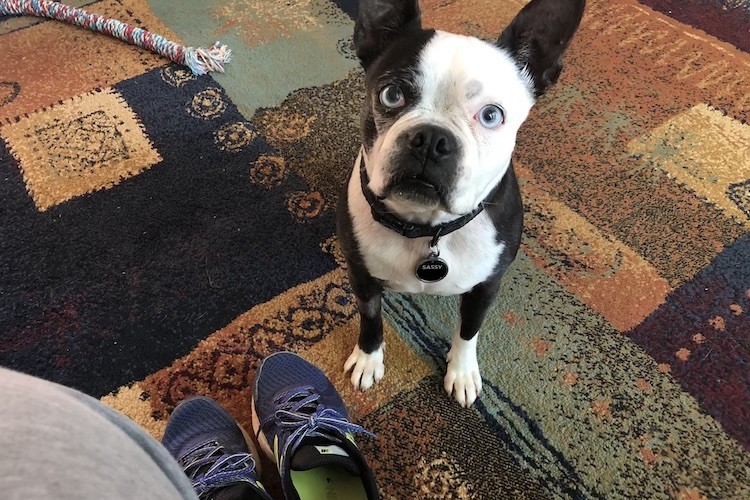
Separation Anxiety Versus Isolation Distress
Pat Miller, in her article on Separation Anxiety for Whole Dog Journal, breaks the differences down in two ways:
- Distress vs Anxiety
- Isolation vs Separation
In the first distinction, distress is a lower level of intensity in behaviors whereas anxiety falls into the panic spectrum.
Isolation in this context means the dog doesn’t want to be alone. Any human or even another pet serves as company and comfort for the dog. Separation, on the other hand, has an attachment factor. A dog with separation issues is bonded with (usually) a human and becomes anxious when that particular human is absent.
Charlie’s Story
My mother’s dog, Charlie is this way. Charlie is attached to her. Over time, he’s been able to adapt to her brief errands away from home. But the other week, my mother needed outpatient surgery, and she left the house in the wee hours of the morning before Charlie was awake.
Poor little thing was distraught and even though she returned home by 10 a.m., his anxiety was so high he didn’t eat anything that whole day and it was later the following day before he finally felt like eating. It’s possible that if mom had woken Charlie up, he’d seen her leave the house, he wouldn’t have been so anxious when he awoke and found her “missing.”
Emmy Lou
Emmy Lou, a deaf foster dog, taught me a lot about separation anxiety in dogs.
I first thought she had an extreme case of separation anxiety based on reports from previous foster homes. I did what I always do, I put dogs in crates (I was told she was crate trained) and Emmy Lou bloodied her bedding. I thought she was bleeding to death!
I could not get her to settle down. It finally occurred to me that I should set up a camera. I used my iPad set to video.
I left Emmy Lou loose in the house, and watched her have a moment of distress – she paced back and forth as she watched me back the car out of the driveway. As soon as my car disappeared from her view, she curled up on the back of the sofa facing the windows and waited to “hear” me arrive back home.
She didn’t have severe separation anxiety, she had severe crate aversion! She used her eyes to hear – she needed to be able to look out the window to see me come home. She was never confined to a crate again, and she and I began a wonderful journey of discovery.
Read Emmy Lou’s story here.
During COVID-19, Prevent separation anxiety with your dogs or foster dogs
Recreate Pre-Pandemic Routines
First, spend a few minutes recalling your pre-stay-at-home schedule. Write it down.
- What time did you get up?
- What was your morning routine?
- What was your dog’s morning routine?
- How or where did your dog stay while you were away?
- Did they stay in a crate?
- Did they stay behind a barrier such as an x-pen or baby gate?
- Did they have freedom in the whole house?
Then, think about
- did your dog have any signs of anxiety then?
- Did they follow you around while you were getting ready?
- Did you occasionally find something chewed up?
- Were there scratches on your door?
- Was there an occasional puddle of urine in an odd place?
Film your dog while you are away
If you aren’t sure what your dog is doing while you are away, I strongly suggest you set up a way to watch your dog while you are away. I love the Wyze Camera, but you can use any nanny cam, or iPad, GoPro, or zoom technology, or even facetime. Anything that can video your dog. Most separation anxiety behaviors will display within the first hour, many within the first few minutes.
Recreate Those Routines To Help Prevent Separation Anxiety.
1. Find reasons to leave the house
Help your dog practice being left behind. Put a camera on them to see what they do in your absence.
Leave the house in your car. Get in your car and drive down the street. Pack a picnic. Go get take-out. Pretend you need milk from the store. Stay gone 5 minutes. 15 minutes. 2 minutes.
Go take a walk and leave your dogs at home. I know. It is unnatural, right? But, actually, you might get a better workout walking without your dogs and you are giving them the practice that sometimes mom or dad leave them alone at home.
Do yardwork and leave your dogs inside. Even if you are working in your fenced yard. Do it for half an hour. You don’t have to do it all day.
Go outside with your laptop or a book and leave your dogs inside.
When you go to the bathroom shut the door and leave the dog outside the room.
You get the idea.
When you are leaving your dogs inside the house, mimic the way you’ve been leaving them before you were asked to stay home and shelter in place. Did you leave them in crates? Behind a baby gate or other barrier? With the T.V. on? Did you give them treats or puzzle toys or did you say anything particular to them before you left? Do this ritual now.
2. Act like you are leaving the house.
Your dogs watch you as you are getting ready to leave the house. They watch your ritual. Your dog knows the order in which you do your grooming to get ready to leave! As you move through your ritual, your dog’s anticipation builds.
For my dogs, the cues seem to be: I change out of my pajamas (ha! TMI?) I put on shoes, (I’m usually barefoot) or I grab my car keys.
Shoes = my human is leaving.
Keys = I might be left alone.
When we pretend we are leaving, we have an opportunity to change the meaning of putting on shoes or picking up keys or in my case, changing into street clothes.
Over time, with repetition, our dogs will accept that nothing bad happens when we pick up keys or put on shoes and they begin to not react emotionally to those activities.
Shoes = meh. My human put on shoes.
Keys = meh. nothing exciting is going to happen.
Start doing these things when you aren’t going to leave the house. Pick up your keys. Put them down. Put them in your pocket. Walk around with them for a minute. Put them back where you usually store them. Do the same thing for any cue your dog recognizes as your ritual for leaving the house. Make keys, shoes, jackets, coffee, hairdryers as mundane as flipping on a light switch.
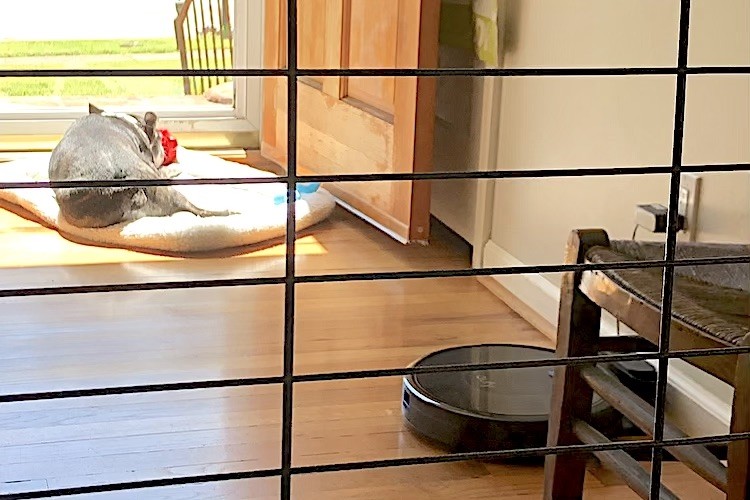
3. Crate or isolate your dogs for a period of time every day.
Even if you don’t leave the house.
When you give your puppy, dog or foster dog time alone, it allows them to increase their independence skills and tolerance for being alone.
A few years ago, I proudly informed my trainer that I crated Otis every afternoon from 1 pm -2 pm. She suggested I might want to not be so rigid in my schedule so that Otis would learn some flexibility.
Indeed, Otis likes a lot of predictability and when his schedule is varied too much for too long, he has a hard time. It is something we work on.
I learned to use the crates for all sorts of activities. Sometimes my dogs get their meals in their crates. Sometimes they sleep in their crates at night. Sometimes they have “crate time” in the morning, sometimes it is the afternoon. Sometimes it is for 15 minutes, sometimes it is for 2 hours.
I might crate them when I walk out to the mailbox or take the trash to the curb. I might leave them loose in the house for those couple of minutes.
Sometimes I crate them when I’m in the room, sometimes I crate them in a different room. If it is pretty outside, I might crate them outdoors.
If your dogs are not crate trained and you are now staying at home, it is the PERFECT time to gently teach your dog to love the crate. Please try. Having your dog accustomed to a crate can be helpful in a variety of situations and emergencies.
How To Crate Train (video)
Other ways to help your dog learn that separation is OK
1. Teach your dog “place”
Teaching “place” means that you train your dog to go to a specific place and stay there, even when you walk away.
This is an important skill and it’s useful for a variety of situations. “Place” teaches independent behavior. Once your dog learns what it means when you say “Place” you can practice increasing time and distance.
Ways to help your dog practice “place”:
- During your mealtimes
- When you are cooking dinner
- When you need to open the front door
- When you are working at your desk
- While you are folding laundry or making the bed
I’ve provided a link to a youtube video at the end of this article if you want some guidance on how to start training your dog to go to “place”.
2. Practice using barriers to teach your dogs to settle
Get a baby gate or x-pen. Put your dogs on the other side of the barrier and attach a treat bag to your waistband. Using random reinforcement, reward any positive behavior you see: four feet on the floor, quiet, laying down, looking away from you. Your dog will repeat a behavior that is rewarded.
Another way to teach your dog to settle is to use food puzzles, kongs, bully sticks, etc to keep them occupied behind a barrier while you work, do chores, jump on a conference call, or search the internet. Over time, try to increase the distance between you and the barrier to increase your dog’s independent behavior. Continue to reward the desired behavior you see.
3. Use Music or the TV to help soothe and manage environmental noise
Scientific studies have shown that classical music helps reduce stress in dogs. It also masks external noise, so if you happen to be crating your anxious dog in another room, music can help cover up the noises you make while you are inside. Through A Dog’s Ear is a great source of music for dogs. I use the CDs and I do see results. I understand the music is also available on Spotify.
I’ve never used DogTV but I know some who have a membership – if you use DogTV with an anxious dog, let me know how it’s working for you.
Helping A Dog With Severe Separation Anxiety
Sometimes separation anxiety is severe and possibly life-threatening. The good news is: there is hope.
If you think your dog’s separation anxiety is severe and you don’t know what to do, please reach out to a specialized trainer. There are specialized trainers with expertise in separation anxiety who are providing help through virtual tools, so you have access to resources beyond your local dog trainers.
Teach Your Dog Skills To Prevent Separation Anxiety.
Whether or not your dog has separation anxiety, isolation distress, or is just darned excited to have you home all day, practicing the above activities will help the transition back to work smoother for you and for your dog. Teaching your dog how to be relaxed, calm, and content in your absence now will make the shift to a new schedule much easier for you and your dog. With all of this imposed free time, you have the perfect opportunity to provide your dogs with new and positive independence skills.
Extra Resources on Preventing Separation Anxiety in Dogs
Why and How Dogs Develop Separation Anxiety
Beginning Mat Training (Place) with Your Dog (video)
Popular Posts
How To Foster Dogs – 10 Skills You Need To Know
Letting Your Foster Dog Go – Tips For Adoption

